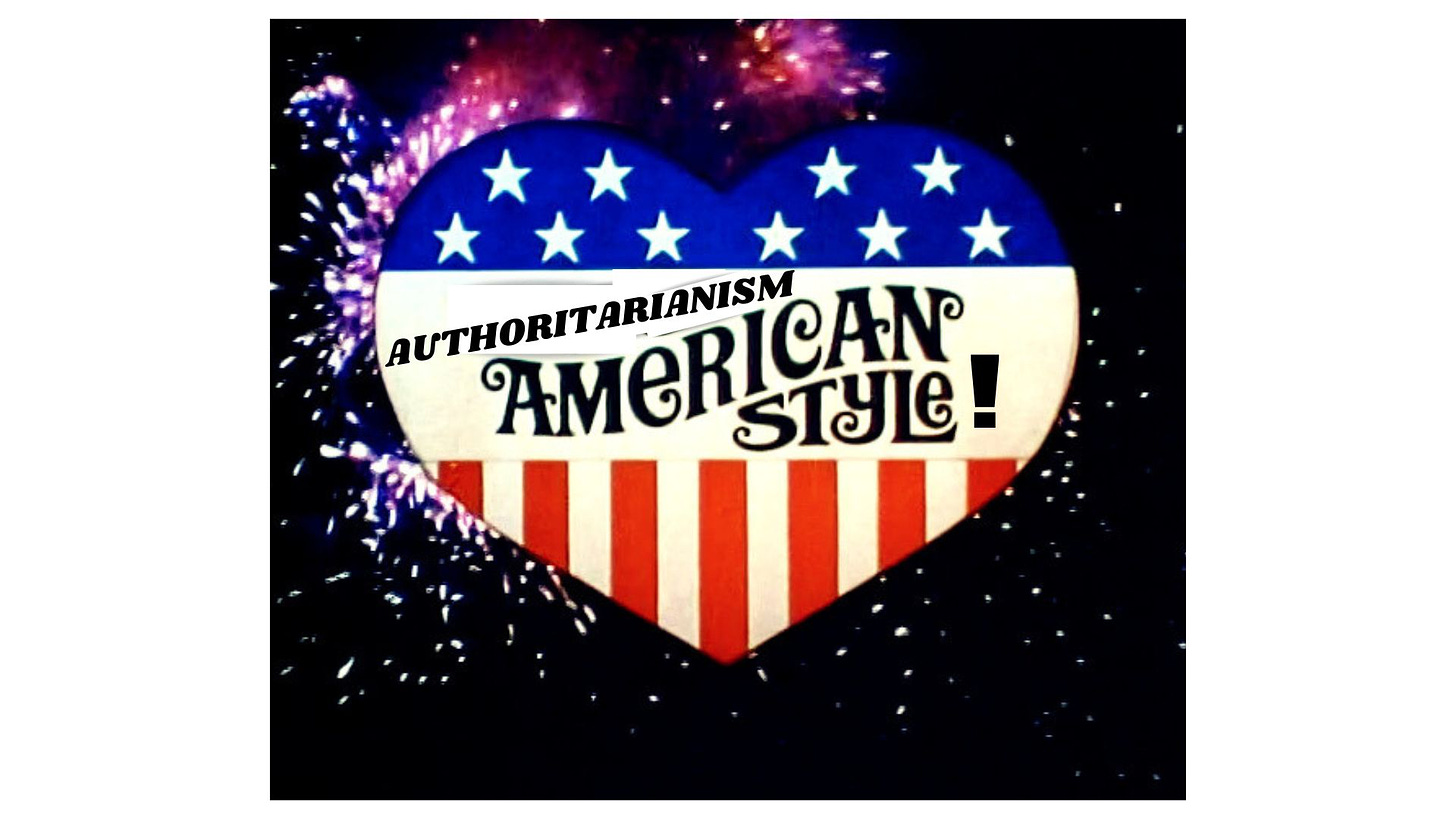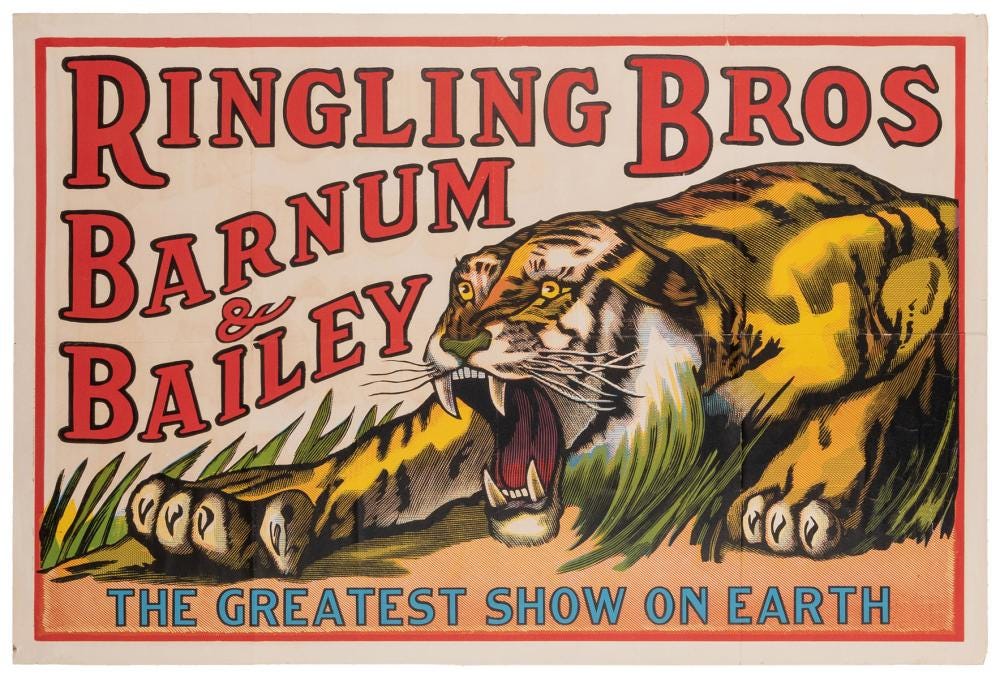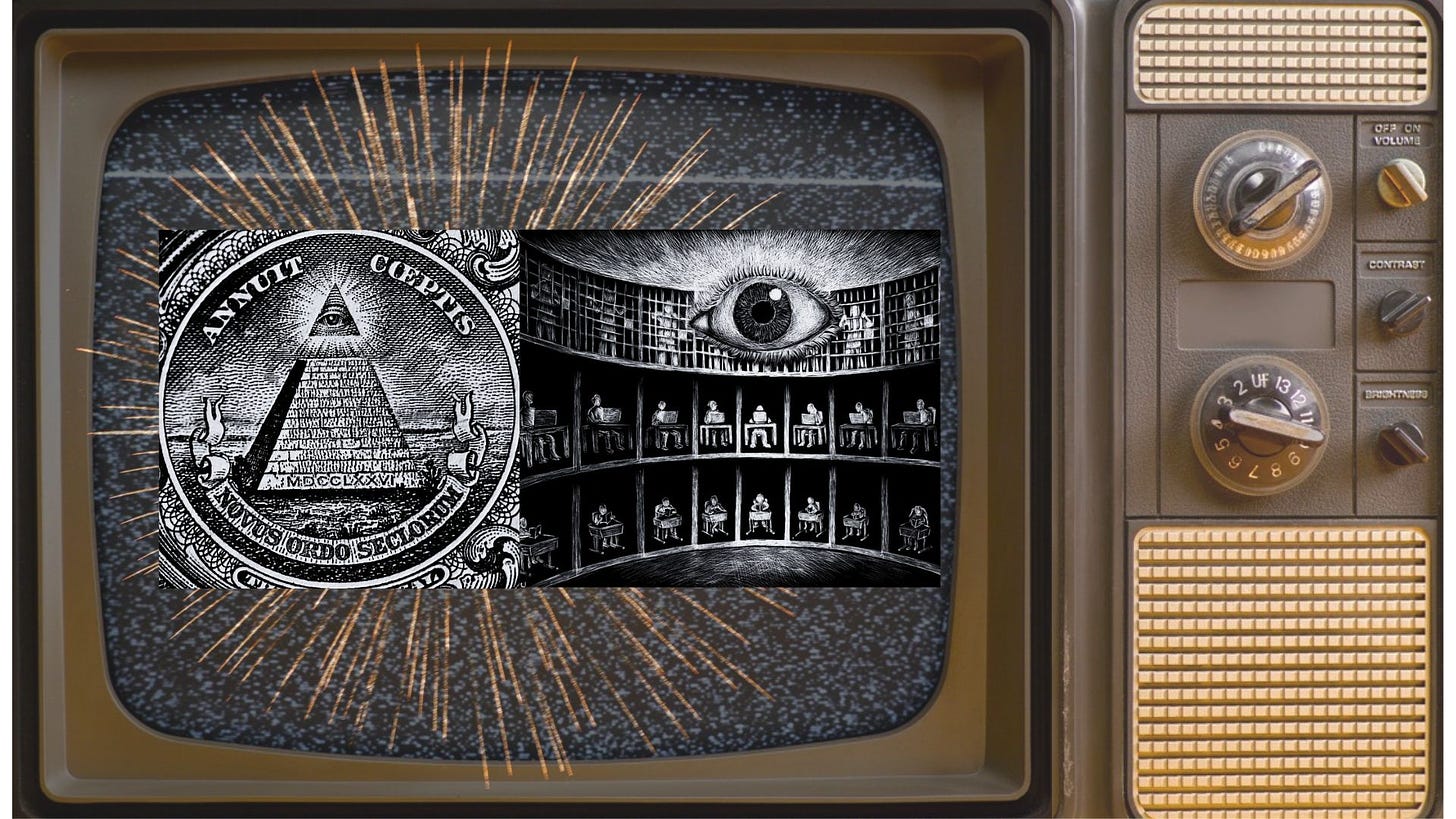
I watched the most TV in my life back in the ‘70s. If I had nothing to do after school — which was often the case in those unscheduled, unsupervised, late 20th-century days — I’d come home, have a snack, flip on the television, post up on the couch, and happily course through a sequence of half-hour sitcoms until dinner. By far, my favorite line-up was Gilligan’s Island, I Dream of Jeannie (so politically incorrect by today’s standards, it’s laughable), and Bewitched.
And once in a while, I’d watch Love, American Style, the show that inspired the title of this post. Even though I didn’t like it nearly as much as the others, its catchy theme song is forever branded into my brain, right along with commercial jingles such as “I wish I were an Oscar Mayer wiener, that is what I’d truly like to be-e-e!,” “I’m Cuckoo for Coco Puffs! “I’m Cuckoo for Coco Puffs!,” and, of course, that absurdly iconic height of early ‘70s flower-power commercialism (so memorably reinscribed in the cynically hilarious Mad Men finale):
“I’d like to teach the world to sing in perfect harmony . . . I’d like to buy the world a Coke and keep it company . . . That’s the re-al thing!
All of that was back in the day when there were only five TV stations to choose from: The commercial big three of ABC, NBC, and CBS; “your local public television station, PBS”; and Chicago’s own hometown network, WGN. And that, my friends, was that. If you wanted other media options, you had to buy print newspapers or magazines, shop at the record store, or go to the movies.
Today’s media environment is so radically different that it’s impossible to recall what it really felt like to live in a world with no smartphones, no email, no texts, no Google, no Facebook, no Twitter/X, no Netflix, no Amazon . . . no nothing except for a few TV stations, snail mail, print journalism, movie theaters, and brick-and-mortar stores.
Hell, we didn’t even have cordless phones, answering machines, or call waiting! If you wanted to call someone, you had to use a phone that was plugged into the wall, with a rotary dial base (or if you were fancy, a pushbutton) and a talk/listen handset connected by a curly, plastic-encased, and always tangle-prone wire. And if no one answered your call — well, you just had to forget it or try again later.
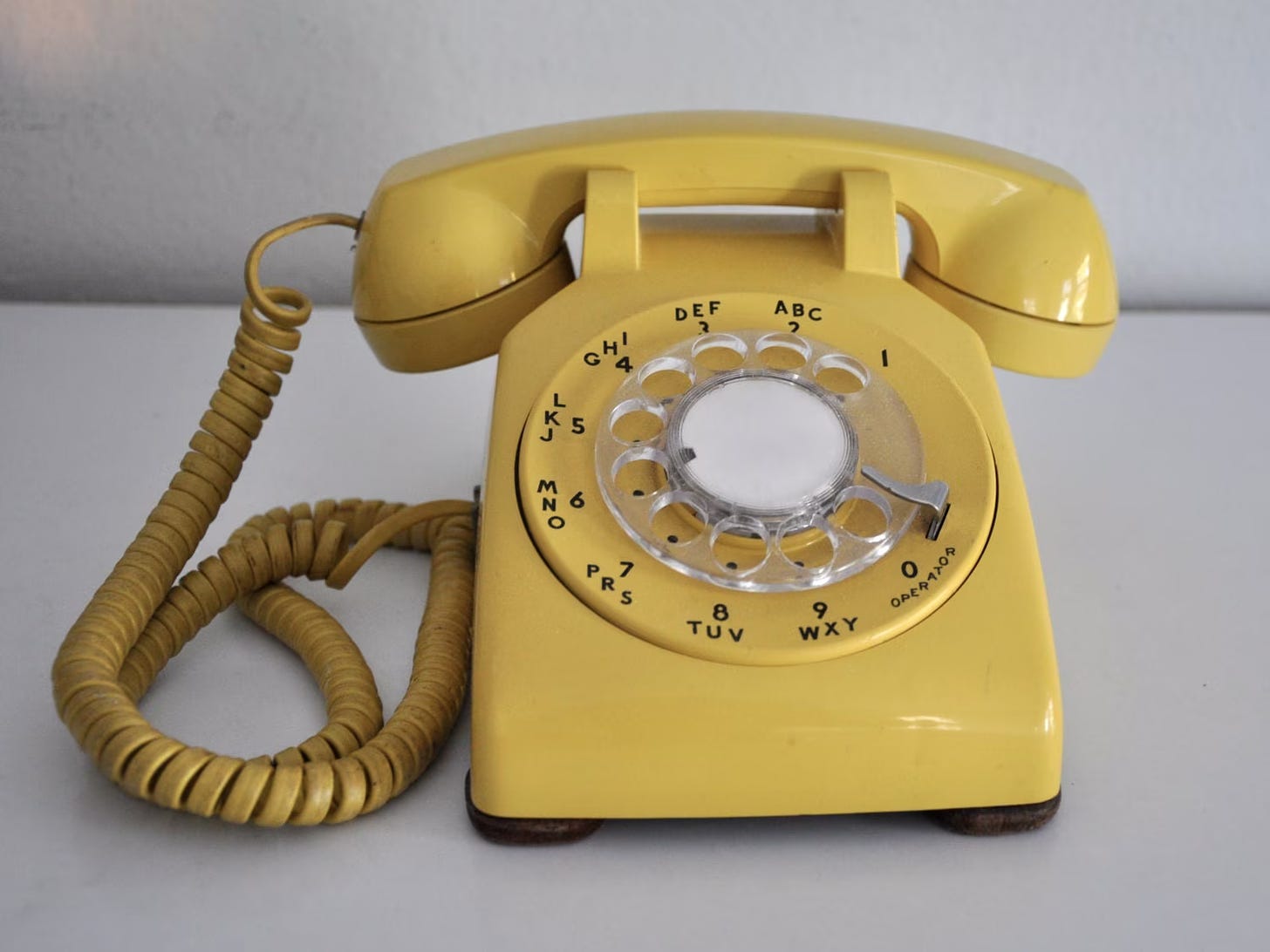
It’s an odd paradox. Back when our communication, information, and media sources were so much more centralized and limited, American culture felt incommensurably more creative, dynamic, and free. Logically, you’d think it would be the opposite. But that’s so much not the case, it’s confounding. What happened to that jet engine of American cultural vitality I grew up with and long took for granted? It feels like it’s disappeared.
But I like to remain hopeful. So I tell myself that it can’t simply be gone. It must be that it’s just so suppressed, repressed, threatened, corralled, marginalized, and disrespected that it feels that way. There must be more creative ferment out there in the culture than I can access or see.
Even so, the sense of loss is profound. Yet it also feels counterintuitive and strange. After all, almost everyone today can easily access a literally endless array of articles, books, videos, films, TV series, etc. If they like, they can even produce and share their own creative work for little to no cost beyond that of a basic smartphone.
Consequently, you’d think this would be a time of great and perhaps even unprecedented creative dynamism, with a dazzling array of intellectual thought and artistic experimentation. And that vision was, in fact, part of the promise of the old Silicon Valley utopianism as recently as the early 2010s. Yet it’s not like that at all, is it? On the contrary, American culture feels stuck, stagnant, shallow, corrupted, decadent, one-dimensional, and dull.
57 Million Channels, Only One Show On
In the early ‘90s, Bruce Springsteen had a hit song, “57 Channels (And ‘Nothin’ On).” At the time, it was taken as an allegorical commentary on the vapidity of our then-recently expanded cable TV universe: We’d gone from five channels to 57, yet what was on offer was weirdly less engaging than before.
Ah, those sweet innocent days of yore! Now, with the Internet, our 24/7 spin cycles, and the poisonous partisan politicization of everything, it feels like there are 57 million channels — but only one show on. And to make matters worse, it’s a rerun: Even though 67% of Americans don’t want to see it, it’s 2024 and we have no choice other than to watch the much-hated “Trump v. Biden” series again.
Wearily, cynically, and humorously, I can’t help thinking of the whole dismal spectacle as “Authoritarianism, American Style!” (Apologies to my younger readers, I know this reference will almost certainly be lost on you. Just know that it may be darkly humorous to at least some of your politically jaded elders.) Because the whole “Trump v. Biden” setup feels like a perverse combo of cheap sideshow entertainment and serious sociopolitical threat at the same time.
It’s a clichéd take by this time. Nonetheless, it’s simply true that there’s an effably American, P. T. Barnum-like quality to Trump — and it’s absolutely central to his stunning degree of success. And as much as the Democrats denounce this former reality TV star as a “fascist,” the truth is that they’d be lost without him. Stuck in a web of their own making with nothing to offer the public other than an unpopular octogenarian candidate who’s widely believed to have dementia, they want and need Trump to stay in his starring role in this series just as much as he does.
In 2019, The New Yorker featured a long review of Barnum: An American Life, a 352-page biography of P. T. Barnum, co-founder of the world-famous “Barnum & Bailey Circus.” Pointedly, the review’s absurdly long title read: “What P. T. Barnum Understood About America: The “Prince of Humbugs” was a liar, a racist, and an entertainer who would do anything for a crowd. He even considered running for President.”
Gee, I wonder who The New Yorker, that avatar of elite-and-proud tote bag progressivism, might be referring to here? While the reviewer never mentions Trump by name, the fact he’s the target is beyond obvious:
Barnum lied easily and often. When he was not fabricating, he was exaggerating; he routinely inflated how much he’d spent on his various business ventures. He may or may not have said, “There’s no such thing as bad publicity,” but certainly he believed in this maxim and welcomed any imbroglio that would be noticed by the press. (Many times, he staged controversies for the express purpose of generating coverage.) He made a fortune, then lost it. While broke, he gave speeches on “the art of money-getting”; improbably enough, these proved extremely profitable. Toward the end of his life, Barnum toyed with the idea of running for President. His running mate, he suggested, should come from a state like Indiana. Barnum called himself the “Prince of Humbugs,” which, generously and perhaps presciently, left open the possibility that one day there would arise a king.
And isn’t it lucky for the Democrats that one did, hmmm? Because really, by far the biggest thing that Joe Biden and the rest of the Democratic Establishment have going for them is that they’re Not Trump. And they know it.
That’s why despite their nonstop posturing about how us Blue Staters must turn out to vote (not to mention, donate) to “Save Our Democracy” from Trumpian “fascism,” they’ve nonetheless been busily pouring tens of millions of dollars into the campaigns of the most far-right MAGA candidates they can find.
And from their cynical perspective, why not? After all, the show must go on!
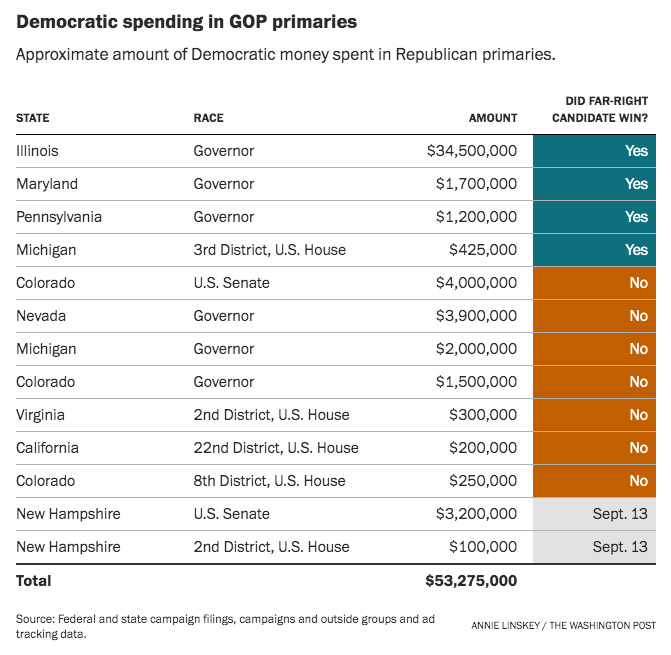
Last fall, NPR reported with unintentional irony that President Biden had been giving a series of “rousing re-election speeches” at private fundraising events “where cameras aren't allowed.” At one such event, a packed NYC theater where “about 1,500 donors shelled out $250 to $7,500 to hear him speak alongside Broadway stars like Lin-Manuel Miranda and Josh Groban,” Biden warned that "Donald Trump and his MAGA Republicans are determined to destroy American democracy." Framed thusly, Biden’s run at 81 years old isn’t the desperate attempt of an ossified party to hold onto power at all costs. No, it’s yet another round of selfless sacrifice to Save Our Democracy: "I'm running because we've made progress,” Biden said with a handwave to his record, “but” (to get back to the main point) “our democracy is still at stake.”
That, however, was just the warm-up act. Last month, Biden upped the ante by literally comparing Trump to Hitler in his first public speech of the 2024 election season:
Whether democracy is still America’s sacred cause is the most urgent question of our time. And it’s what the 2024 election is all about. The choice is clear . . . (Trump) talks about the blood of America being poisoned, echoing the same exact language used in Nazi Germany . . . There’s no confusion about who Trump is, what he intends do.
For what it’s worth, the full context of Trump’s “poisoning the blood of our country” comment can be found here. It was embedded in a much longer list of charges about the dangers of the unprecedented explosion of illegal southern border crossings under the Biden administration: “They come from prisons,” Trump ranted, “ . . . mental institutions . . . they’re terrorists . . . people are coming in with disease.” Consequently, Snopes (in an always dubious “fact check”) concluded that Trump was probably not making a racialist allusion a la Hitler, but rather “claiming that immigrants bring dangerous drugs and diseases across the southern border” — a contention that, stated so blandly, would be hard for any honest broker to deny.
But Trump, of course, isn’t the least bit interested in making any such calmly factual statements. On the contrary, he’s America’s hands-down political champion of emotionally inflammatory invective, with a preternatural ability to rouse both the profound passions of his supporters and the deep hatred of his opponents. The resultant whirlwind works to his advantage, as the blind fury and visceral fear evoked in those who hate him energizes and delights the MAGA faithful: Their champion has an unerring ability to “own the libs” in the most deliciously devastating ways.
Trump is nothing if not a master of divisive hyperbole. To take just one of an endless number of examples, his 2023 Veterans Day speech (which was accompanied by a parallel post on Truth Social) set off another round of Hitler comparisons among Blue State loyalists with its characterization of America’s “radical left” (which was also held to include “fascists,” but whatever) as “vermin”:
With your help, your love, and your vote, we will put America first.
And today, especially, in honor of our great veterans on Veterans Day, we pledge to you that we will root out the Communists, Marxists, fascists, and the radical left thugs that live like vermin within the confines of our country.
That lie and steal and cheat on elections and will do anything possible — they’ll do anything, whether legally or illegally, to destroy America and to destroy the American dream.
Consequently, the New York Times, Washington Post, The New Republic, the Biden administration, and many others promptly accused Trump of “echoing Nazi propaganda.” “Trump has reportedly studied Hilter,” charged Forbes, “and expressed admiration toward the Nazi dictator to people close to him.” (Trump denied having ever made the statement cited to back up this claim.) Meanwhile, Trump campaign spokesman Steven Cheung happily hit back against this latest wave of successfully generated Blue State hysteria: “Those who try to make that ridiculous assertion,” he told the Post, “are clearly snowflakes grasping for anything because they are suffering from Trump Derangement Syndrome and their entire existence will be crushed when President Trump returns to the White House.”
Owning the libs again, ka-ching! Because while that comment sent off another round of Team Blue frenzy about “dictatorial threats,” the plausible deniability that Trump always so deftly employs was still there. After all, couldn’t you quite reasonably claim that all Cheung meant was that those legions of TDS-ed “snowflakes” who so love to posture about “Saving Our Democracy (TM)” won’t be able to take it when their hugely unpopular and obviously senile octagenarian candidate loses to Trump in a legitimately democratic election? After all, they couldn’t in 2016. And Trump is consistently ahead in recent polls.
And so the endlessly hyperbolic Trump v. Biden show goes on . . . and on . . . and on. For their part, the Red and Blue faithful continue to avidly follow every twist in its now tired plot. The rest of us, though, are stuck toggling between staring at the whole sorry spectacle in disaffected horror and trying to tune the blasted thing out.
The Populist Strongman and the Post-Liberal Panopticon
Unfortunately, however, the stakes are too high to write off the Trump v. Biden show as nothing more than a cheap spectacle that can be easily ignored. Who becomes President matters. And the ripping of the social fabric and shredding of democratic “mores” (the culturally embedded beliefs and practices critical to sustaining democracy) that it generates matters even more.
Plus, both Team Red and Team Blue are already alarmingly authoritarian enough as it is. True, the charges and counter-charges of “fascism” and “communism” are hyperbolic and misleading. The Trump faithful aren’t Nazis and partisan Democrats aren’t Communists. To the contrary, the majority are well-intentioned people who would be able to forge a working alliance on many if not most important issues if only we had good political and cultural leadership, as opposed to the nonstop pushing of division, scapegoating, and demonization we’re inundated with instead. While a vocal minority of fanatics and opportunists thrive on this cynically manufactured enmity, the rest of us not only suffer, but are sadly susceptible to being sucked into these destructive dynamics ourselves.
The societal power of the Red/Blue narrative convinces far too many people who would in other circumstances know better that they must be undyingly loyal to one of the two bad options on offer: That is, the populist strongman championed by Team Red or the corrupt Establishment represented by Team Blue. Take your pick!
Both sides paint themselves as the one and only savior of American democracy and the other as an existential threat. But in truth, both have alarmingly authoritarian tendencies that could easily grow worse — and potentially, much worse. Depressing as it is to recognize this squarely, it’s nonetheless a better option than getting sucked into the dominant downward spiral.
On the Red side, Trump’s P. T. Barnum-style showmanship fits right into the classic “strongman” populist leader prototype. As Pierre Lemieux explains:
Strongmen share many common traits. They claim to embody the “will of the people,” and they clash with political, legal, and private institutions that limit their power. They are nationalists. They often present themselves as defenders of religion despite their frequent personal impieties and moral flaws. Toughness (if not cruelty) is an important part of their image. They are liars or ignoramuses or both.
Many Trump supporters argue that while he may indeed have a “difficult personality,” that shouldn’t overshadow the fact that he’s been pushing a much-needed political transformation. To many, he’s a champion of a working and middle class that’s been exploited, abandoned, and disrespected by a corrupt and elitist Establishment. From this perspective, such worries about Trumpist authoritarianism are nothing more than a misguided obsession with some random rash comments, bullying behaviors, and “mean Tweets.” Focusing on that while ignoring the most vital issues at hand, they argue, is counterproductive.
However sincere such contentions may be, they nonetheless willfully ignore the inherent dangers of Trump’s expert cultivation of a cult of personality that — in classic strongman mode — is both legitimately populist and dangerously authoritarian at the same time.
Trump is a legitimate populist because he has indeed channeled the anger and frustration of a huge proportion of the U.S. population, many of whom have been and continue to be badly treated by the ruling elite. At the same time, though, he’s also a potentially dangerous authoritarian in that his “l’etat, c’est moi” way of operating is fundamentally antithetical to both the culture and structure of liberal democracy.
If Trumpian authoritarianism fits a culturally familiar strongman formula, Blue State authoritarianism, in contrast, is conceptually unfamiliar and relatively hard to define. Unlike Trumpism, it doesn’t fit a classic hierarchical model, with one supremely powerful leader at the top who commands a loyal army below. Instead, it functions more like Foucault’s power/knowledge panopticon: With the right structure in place, everyone polices themselves and each other into obedient social conformity, regardless of whether a dictating authority is actively demanding compliance at any given time or not.
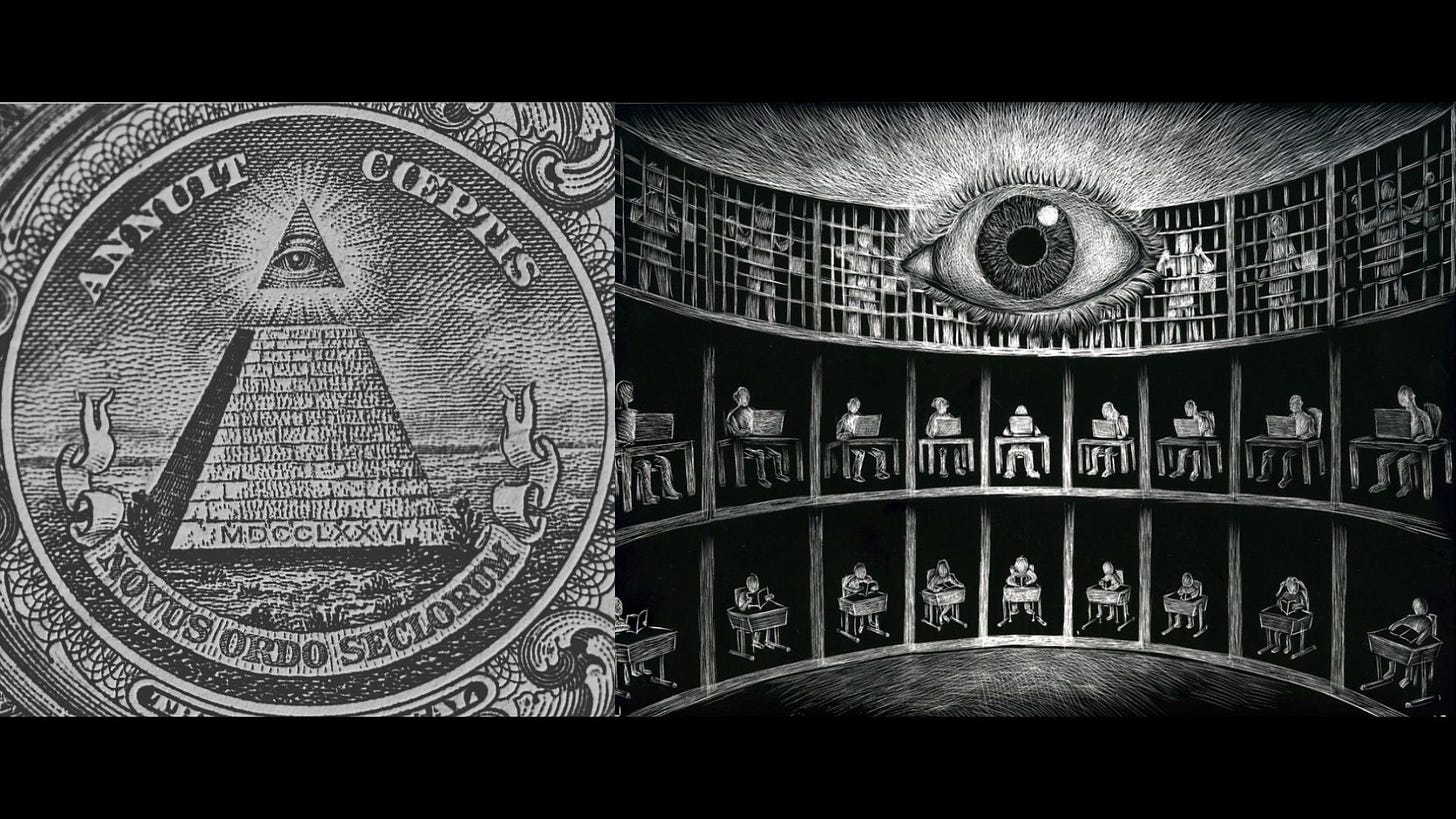
In Discipline and Punish: The Birth of the Prison (1975), Foucault famously turned the structure of the panopticon — a prison in which every inmate can always observe and be observed by others, as well as by an unpredictably attentive all-powerful central authority — into a concept that (in his view) described the operation of power in modern Western societies. Put crudely, his message was that the West’s embrace of Enlightenment values (humanism, liberalism, etc.) had produced the exact opposite of what has been traditionally claimed: Rather than generating a progressive expansion of individual rights and freedoms, it subjected everyone to a new regime of totalizing oppression.
For those not familiar with it, Foucault’s core argument goes something like this: Back in the old days, when the King ordered his enemies slaughtered and their heads put on pikes outside the castle gates, it was obvious to everyone precisely where political power was located and how it was exercised. Under a self-styled liberal democratic regime in which we all supposedly share the same rights and responsibilities of self-governance, in contrast, there is no such clarity and transparency. Consequently, we are deeply socialized to internalize ways of thinking, feeling, and behaving that conform to an opaque, yet all-pervasive system of power/knowledge.
This fundamentally anti-liberal view of modern society has deeply influenced America’s so-called “intersectional left.” Whether your garden-variety wokester has studied Foucault or not, their assumption that it’s righteous to police even the most intimate minutia of other’s thoughts and behaviors because it will somehow “disrupt” the totalizing web of oppressive power/knowledge we’re all enmeshed in represents a brutally concrete application of his abstract philosophical thought.
Ironically, the woke, or post-liberal progressive insistence on “resisting” what’s seen as all-pervasive oppression is precisely what has provided the rationale for building a legal-bureaucratic corporate/state apparatus that not only exerts an unprecedented degree of control over everyday life, but is dedicated to policing what most people consider to be “normal” thought and behavior. (See, for example, “dismantling the gender binary.”) Because again, in the Foucaultian view of the world, whatever’s considered “normal” is, in fact, innately oppressive.
Examples of this new post-liberal progressive panoptic regime include the shockingly expansive and dysfunctional Title IX bureaucracy in K-12 schools, colleges, and universities (be sure to read the California Law Review article, “The Sex Bureaucracy,” if you haven’t already); the bloated overreach of the counterproductive DEI industry; and the rapid development of the so-called “war against disinformation,” which seeks to coordinate elite control over political information and narratives among a wide range of public, private, and nonprofit actors. The reach of these new systems is vast, encompassing countless educational institutions, corporations, tech firms, professional associations, healthcare providers, media outlets, and nonprofits both nationally and internationally — who, in turn, exercise control over millions of students and employees, as well as the various forms of media that most of us consume every day.
None of this, of course, is openly acknowledged, let alone critiqued in polite Blue State society. Whenever I try to bring something along these lines up socially, I’m almost always met with blank stares, pushback, and/or a quick change of the subject. Even people who have tangled unhappily with one of these progressive bureaucracies themselves are typically loathe to discuss it, even in safely private settings.
As I’ve written about many times before, there’s a new culture in Blue State America. The values and sensibilities of the old progressive liberalism that used to define it have been subsumed by those of the new post-liberalism progressivism, or wokeism. In the process, the once taken-for-granted sense of freedom, creativity, and experimentation I grew up with has been replaced by a new cultural order that valorizes conformity, demands self-censorship, and justifies the surveillance state. (As Politico so pithily put it, “where some see conspiracy, others see accountability.” But of course.)
Someday (Maybe Soon) the Channel Will Change
For the moment, we’re collectively stuck in a rerun that very few want to see. But as we all know, there’s no way this stasis can last. For starters, there’s obviously the election in November. Then there’s the uncertainty that inevitably surrounds the stars of this miserable show: Two men who live under extreme stress every day, one in his late 70s and the other in his early 80s. No matter how you cut it, that’s old — and very old to be doing what they’re doing. It’s only a matter of time; something’s gotta give.
So the channel will change. We’re not sure when. But we know the day can’t be far off. And so the obvious question looms: What then? What’s next? We’re so used to being stuck in our current rut, it’s hard to imagine being out of it.
Needless to say, however, the river of paranoid imaginings runs high. Naturally, there’s even a new “Civil War” movie coming to a theater near you this spring! Just in time to get everyone in a good, positive, conciliatory mood for the summer’s DNC and RNC conventions. Thank you, Hollywood!
The funniest moment in Jon Stewart’s recent monologue marking his return to The Daily Show was when, after mocking both candidates, he asked, “so, what’s the good news?” and then paused, looked deadpan at the camera, and followed up with . . . nothing. (Back in form, Stewart makes this extremely humorous. Unfortunately, it doesn’t translate well into print.)
Stewart’s dark humor rings true. Nonetheless, in the spirit of staying positive and keeping hope alive, I like to think of the situation this way:
Even though authoritarian tendencies are in evidence on both sides of the Red/Blue divide, the U.S. is a huge, complex, and diverse society with multiple centers of political, economic, and cultural power. This is by design: As James Madison so famously argued in Federalist 10, our vast size and variegated federal system make it extremely difficult for any one political faction, no matter how fanatical, to take over everything. Contra Foucault, power is simply too fragmented for any one party to seize comprehensive control.
These same factors also make it impossible for anyone to know the true range of what’s happening in the country. On the positive side, this means that there must be a whole lot more creativity, dynamism, and innovation out there than any of us can be aware of. As long as we’re collectively stuck watching the Trump v. Biden rerun, though, none of that can come to the fore. Once that logjam is broken, however — which, again, has to happen soon — there may be much more room for new possibilities to emerge. And while some will be negative and destructive, others may well be positive, constructive, and inspiring.
We can only hope for now. But in the meantime, we can individually and collectively dedicate ourselves to doing the best that we can within the circumstances we are given. In this way, we can both prepare the ground for better days and strengthen the body politic against whatever negative attacks on it are sure to come. This requires, however, enduring the Trump v. Biden rerun without getting swept up in the division and drama — and committing to the principle that whatever the outcome may be, we’ll keep on keeping on nonetheless.
Circling back to more of the 1970s references we started with, I find inspiration in the song “Higher Ground,” which was written and recorded by Stevie Wonder (who also played all the instruments on this track) in only three hours back in 1973. And so, I suggest: Turn off the TV, bring on the funk, put on your dancing shoes — and enjoy!




